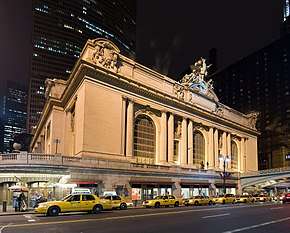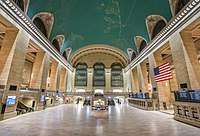MetLife Building
The MetLife Building is a 59-story skyscraper at 200 Park Avenue at East 45th Street above Grand Central Terminal in Midtown Manhattan, New York City. Built in 1963 as the Pan Am Building, the then-headquarters of Pan American World Airways, it was designed by Emery Roth & Sons, Pietro Belluschi and Walter Gropius in the International style. The Metropolitan Life Insurance Company (MetLife) bought the building in 1981 and used it as their headquarters. MetLife sold the building in 2005. The world's largest commercial office space by square footage at its opening, it remains one of the 100 tallest buildings in the United States.
| MetLife Building | |
|---|---|
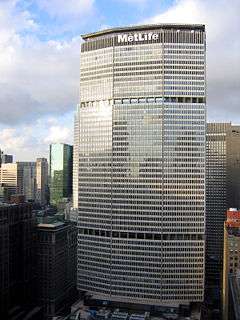 | |

| |
| Former names | Pan Am Building |
| General information | |
| Type | Office |
| Architectural style | International |
| Location | 200 Park Avenue Manhattan, New York 10166 U.S. |
| Coordinates | 40°45′12″N 73°58′36″W |
| Construction started | November 26, 1959 |
| Topped-out | May 9, 1962 |
| Completed | 1963 |
| Opening | March 7, 1963 |
| Owner | Tishman Speyer, The Irvine Company |
| Height | |
| Roof | 808 ft (246.3 m) |
| Technical details | |
| Floor count | 59 |
| Floor area | 2,841,511 sq ft (263,985.0 m2) |
| Lifts/elevators | 23 |
| Design and construction | |
| Architect | Emery Roth & Sons, Pietro Belluschi and Walter Gropius[1] |
| Structural engineer | The Office of James Ruderman |
| References | |
| [2][3] | |
History
Construction
Plans for what is now the MetLife Building date to 1955, when Grand Central Terminal was proposed for demolition.[4] Developer Erwin S. Wolfson proposed a 65-story tower called Grand Central City to replace the six-story baggage structure (which had by then become an office building) north of the terminal.[4] He revised the plan in 1958, downsizing the tower to 50 stories. The tower would contain three movie theaters with a total capacity of 5,000; an open-air restaurant on the seventh floor; and a 2,000-spot parking garage.[5] This plan was ultimately approved.[6] In July 1958, it was announced that architects Walter Gropius and Pietro Belluschi, noted architects in the Modern style, would assist Richard Roth of Emery Roth and Sons in designing Grand Central City.[7] The initial plans called for the tower to rise 708 feet (216 m), with 2,703,112 square feet (251,127.3 m2) of floor area.[8]
A structural steel contract for Grand Central City was awarded to U.S. Steel's American Bridge division in May 1959.[9] Construction on the $100 million structure officially started on November 26, 1959.[10] In order to make way for Grand Central City, a six-story baggage handling building was demolished in mid-1960.[11][12] Foundations for the building were sunk in August 1960.[13]
Cushman & Wakefield were named as leasing agents for Grand Central City.[14] In September 1960, Pan Am founder Juan Trippe signed a 25-year, $115.5 million lease, allowing the airline to occupy 613,000 square feet (56,900 m2), or about 15 floors, plus a new main ticket office at 45th Street and Vanderbilt Avenue. Thereafter, the structure was renamed for Pan Am.[15] Space was also leased to the Westinghouse Electric Corporation, which agreed to occupy four floors in July 1960.[16] Other early tenants included the Hammermill Paper Company,[17] National Steel Corporation,[18] Kodak,[19] Reader's Digest magazine,[20] Mitsui,[21] and British Iron & Steel Corporation.[22]
The floors of the Pan Am Building were constructed in a manner similar to how bridge spans were built. The builders used a process called composite action, in which concrete was bonded with structural steel panels to create a stronger structure.[23] The tower's structural steel topped out in May 1962.[24]
Opening and occupancy
The Pan Am Building was formally opened on March 7, 1963, despite not being completed,[25] and tenants started moving into the structure the following month.[26] At the time, the Pan Am Building was the largest commercial office space in the world by square footage.[27] It was initially an unpopular sight due to its lack of proportion and huge scale: it dwarfed the New York Central Building to the north and Grand Central Terminal to the south,[28] and it blocked continuous views of upper and lower Park Avenue.[29] The building was surpassed in size by the World Trade Center in 1970 as well as 55 Water Street in 1972.
The Pan Am Building was the last tall tower erected in New York City before laws were enacted preventing corporate logos and names on the tops of buildings.[30] It bore 15-foot-tall (4.6 m) "Pan Am" displays on its north and south faces and 25-foot-tall (7.6 m) globe logos east and west.[31]
Pan Am originally occupied 15 floors of the building. It remained Pan Am's headquarters even after Metropolitan Life Insurance Company bought the building in 1981. By 1991, Pan Am's presence had dwindled to four floors; during that year Pan Am moved its headquarters to Miami. Shortly afterwards, the airline ceased operations. In September 1992, MetLife announced that it would remove Pan Am signage from the building. Robert G. Schwartz, the president of MetLife, said that the company had decided to remove the Pan Am sign because Pan Am ceased operations. At the time MetLife was headquartered in the Metropolitan Life Insurance Company Tower.[30]
In 2005, MetLife sold the building for $1.72 billion, the highest price at the time for an office building in the U.S. The buyers were a joint venture of Tishman Speyer Properties, the New York City Employees' Retirement System, and the New York City Teachers' Retirement System.[32] In 2015, it was revealed that Donald Bren, the billionaire owner of the real estate firm Irvine Company, held a 97.3 percent ownership stake in the building. While Tishman Speyer remains the managing partner of the property, the company's stake in the MetLife Building has been reduced to less than 3 percent.[33]
In 2017, the light source for the "MetLife" sign at the top of the building was changed from neon to LED in order to conserve energy.[34]
Helicopter service
New York Airways flew Vertol 107 helicopters from the rooftop helipad to Pan Am's terminal at John F. Kennedy International Airport from December 21, 1965, to February 18, 1968, when the service ceased due to inadequate passenger loads. For a short part of that time, they also offered service to Teterboro Airport.[35][36]
Service to JFK resumed in early 1977 using Sikorsky S-61s. On May 16, 1977, about one minute after an S-61L landed and its 20 passengers disembarked, the right front landing gear collapsed, causing the aircraft to topple onto its side with the rotors still turning. One of the five 20-foot (6.1 m) blades broke off and flew into a crowd of passengers waiting to board. Three men were killed instantly and another died later in a hospital.[37] The blade sailed over the side of the building and killed a female pedestrian on the corner of Madison Avenue and 43rd Street. Two other people were seriously injured.[38][39] Helicopter service was quickly suspended, and never resumed.[35]
Suicide of Eli M. Black
On February 3, 1975, Eli M. Black, then-CEO of United Brands Company (now Chiquita Brands International), used his briefcase to shatter a 44th-story window and leaped to his death on Park Avenue.[40]
Architecture

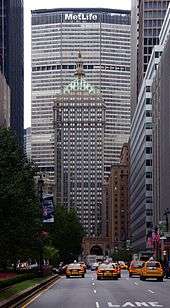
The building remains one of the city's most recognizable skyscrapers. Designed in the International style, the MetLife Building is mixed use commercial and office, with large floor plans, simple massing, and an absence of ornamentation inside and out. The octagon shape and window wall were intended by the architects to reduce the building's perceived sense of scale.[41]
It was not well received by locals or by critics, who viewed the monolithic design as unsuccessful and complained that the building blocked vistas down Park Avenue and toward the New York Central Building, and disrupted traffic at street level.[42]
It has been popular with tenants, not least because of its location next to Grand Central Terminal. The architecture of the building may have been inspired by the Pirelli Tower, built in 1956 in Milan, Italy, which was also a model for the Alpha Tower in Birmingham, England, and other similar buildings in Switzerland and Spain.
In 1987, a poll conducted by the lifestyle periodical New York indicated that the tower was the building that New Yorkers would most like to see demolished.[43] The building is highly visible. Situated behind Grand Central Terminal outside of the grid, the building, which would have otherwise been tucked away into the city, is left exposed and is a contrast with the other buildings around it, most notably the New York Central Building (today the Helmsley Building). The MetLife Building also partially obstructs the view of the Chrysler Building from the Top Of The Rock.
The Sky Club had been located on the 56th floor of the building.[44] Aircraft pioneer and Pan Am founder Juan Trippe used this club.[45]
Tenants
In addition to being the official headquarters of the Metropolitan Life Insurance Company, the MetLife Building houses a number of other major firms, including the headquarters of Dreyfus Corporation, Knight Vinke, the wealth and investment management division of Barclays, the largest office of Greenberg Traurig, DNB, CB Richard Ellis, Gibson, Dunn & Crutcher, Hunton & Williams, DXC Technology, Merrill Lynch, Korn Ferry, Winston & Strawn, Paul Hastings, and Lendlease Corporation on Level 9. In addition the building serves as the U.S. Headquarters for Mitsui & Co. (USA) Inc, the American subsidiary of Japan's largest trading company, BNP Paribas Investment Partners and its American subsidiary Fischer, Francis, Trees and Watts.
NOAA Weather Radio Station KWO35, a National Weather Service radio station, is located atop the building.
In popular culture
- As a Manhattan landmark, it has been seen in films such as Only When I Larf, Coogan's Bluff, Grand Slam, The French Connection, Armageddon, and Catch Me If You Can.
- The building, still under construction, is glimpsed briefly in the 1962 Italian film Mafioso.
- In the 1970 film musical On a Clear Day You Can See Forever, the building is host to Yves Montand singing the first verse of "Come Back to Me" from its roof.
- On the ABC television series Pan Am, the building was shown with the original company logo.
- In the music video for Cher's "(This is) A Song for the Lonely" the building can be seen being constructed and is shown with its original Pan Am company logo, then when the video ends the building can be seen bearing its current MetLife name and logo.
- The building is compared to a tombstone in Joni Mitchell's song "Harry's House".
- The building is briefly shown in the 1989 movie Weekend at Bernies with the Pan Am logo.
- Several pivotal sections of the young adult novel So You Want to Be a Wizard by Diane Duane occur in, atop, or directly adjacent to the Pan Am building (with the name adjusted in the later edition when the timeframe changed).
- The building's outline is briefly shown in the 1988 animated film Oliver & Company.
- The building is shown briefly in the 1986 film Highlander and the 1990 film Quick Change and Gremlins 2: The New Batch, with the Pan Am logo.
- The building also appears partially destroyed in the 1998 Godzilla film, with Godzilla creating a hole after rampaging through the building in its first attack in Manhattan.
- In the Life After People episode "Toxic Revenge", the building collapses 150 years after the extinction of humans due to corrosion and being weakened from explosions caused by a buildup of methane. Its collapse also destroys the insides of Grand Central Terminal.[46]
- It is featured in the 2008 video game Grand Theft Auto IV where it is located in Liberty City as the "GetaLife" Building. The building also appears in Grand Theft Auto: Chinatown Wars, but only the bottom floors are rendered due to the game's top-down angle.
- The building appears in the 2009 movie Knowing, where it is destroyed along with the rest of New York City.
- The building is featured in the Marvel Comics comic book Damage Control #2, where it is partially destroyed by a giant lizard.
- In the 2011 video game Crysis 2, the building is seen at the final part of the fourteenth mission, 'Terminus'. After the protagonist, Alcatraz, and multiple US Marines fend off an assault on Grand Central Terminal by the alien race known as 'The Ceph', who are attempting to stop civilian evacuation via the subway, the building is hit with a Ceph mortar, sustaining heavy damage, and begins to collapse. Alcatraz and the Marines escape via vehicles, but a man waves down the vehicle Alcatraz is in and asks the Marines to help free his wife who is pinned by a metal beam. As the building continues collapsing after being hit with another mortar, the Marines have no choice but to leave the man and his wife behind, speeding away just as the building falls onto Grand Central Terminal, scattering debris and dust everywhere and presumably killing the civilians in the process.
- In the 2012 film The Avengers, a majority of the building is deconstructed to accommodate Stark Tower.[47] After the events of the film, Stark Tower is remodeled into Avengers Tower, briefly appearing in Iron Man 3 and Captain America: The Winter Soldier before fully appearing in Avengers: Age of Ultron. Spider-Man: Homecoming has the Avengers paraphernalia being moved from the building to the team's new base in upstate New York. The building can be seen again in the teaser trailers for Daredevil and Jessica Jones.[48][49] In the trailer for Spider-Man: Far From Home released on 15 January 2019, the Avengers Tower can be seen undergoing work as Spider-Man swings past Grand Central Terminal.[50] It was also featured in a scene cut from Marvel's The Avengers where Steve Rogers is sketching it and the surrounding landscape at a cafe.[51]
- The film clip for Vampire Weekend's song "Ya Hey" was filmed on the rooftop.
- In the 2017 film Kingsman: The Golden Circle, the building appears as the Statesman whiskey New York Branch building.
Gallery
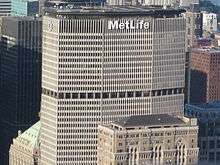 As seen from the Empire State Building
As seen from the Empire State Building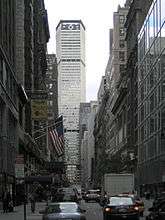 West face from 44th Street
West face from 44th Street- Grand Central Terminal in the foreground
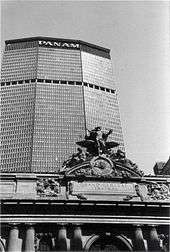 In the 1980s, still known as the Pan Am Building
In the 1980s, still known as the Pan Am Building
See also
- Buildings and architecture of New York City
- Tallest buildings in New York City
References
- Clausen, Meredith (2005). The Pan Am Building and the Shattering of the Modernist Dream. Cambridge, Mass.: MIT Press. ISBN 9780262033244. OCLC 803843211.
Notes
- White, Norval; Willensky, Elliot & Leadon, Fran (2010). AIA Guide to New York City (5th ed.). New York: Oxford University Press. p. 316. ISBN 978-0-19538-386-7.
- "MetLife Building". SkyscraperPage.
- MetLife Building at Emporis
- "NEW PLAN STUDIED ON GRAND CENTRAL; 65-Story Building With Glass Tower Would Spare Present Concourse of Terminal". The New York Times. February 8, 1955. Retrieved December 24, 2018.
- Fowler, Glenn (May 8, 1958). "Grand Central 'City' Is Planned; 50-Story Skyscraper Slated by 1961 for Rear of Terminal GRAND CENTRAL PLANS BUILDING". The New York Times. Retrieved December 24, 2018.
- Langmead, D. (2009). Icons of American Architecture: From the Alamo to the World Trade Center. Greenwood Icons. Greenwood Press. p. 177. ISBN 978-0-313-34207-3. Retrieved December 24, 2018.
- "2 Noted Architects to Help Map Center". The New York Times. July 31, 1958. ISSN 0362-4331. Retrieved December 25, 2018.
- "BUILDING PLAN FILED; Cost of Grand Central City Is Put at $42,000,000". The New York Times. November 25, 1959. ISSN 0362-4331. Retrieved December 25, 2018.
- "Huge Steel Award Let For New Building Here". The New York Times. May 13, 1959. Retrieved December 24, 2018.
- "SKYSCRAPER IS BEGUN; Work Starts on $100,000,000 Grand Central City". The New York Times. November 27, 1959. Retrieved December 24, 2018.
- "WRECKING STARTS AT GRAND CENTRAL; Office Building Being Razed for Skyscraper -- Baggage Installation Advanced". The New York Times. June 28, 1960. ISSN 0362-4331. Retrieved December 25, 2018.
- Schlichting, Kurt C. (2001). Grand Central Terminal: Railroads, Architecture and Engineering in New York. Baltimore: Johns Hopkins University Press. pp. 62–63. ISBN 0-8018-6510-7.
- "Foundation Being Sunk 55 Feet for Grand Central City". The New York Times. August 9, 1960. Retrieved December 24, 2018.
- "RENTING AGENT NAMED; Cushman & Wakefield Gets Job for Grand Central City". The New York Times. December 2, 1959. ISSN 0362-4331. Retrieved December 25, 2018.
- Clausen, p. 137.
- "LEASE EXPANDED BY WESTINGHOUSE; Company Will Take 4 Floors in Grand Central City -- Other Rental Deals". The New York Times. July 28, 1960. ISSN 0362-4331. Retrieved December 25, 2018.
- "SPACE IS LEASED BY HAMMERMILL; Paper Company to Locate in Pan Am Building". The New York Times. June 7, 1962. ISSN 0362-4331. Retrieved December 25, 2018.
- "NATIONAL STEEL TO MOVE OFFICES; Signs at Pan Am Building --Goodrich Expands Unit". The New York Times. May 28, 1962. ISSN 0362-4331. Retrieved December 25, 2018.
- "EASTMAN KODAK TO MOVED DIVISION; Gets Space in the Pan Am Building -- Other Rentals". The New York Times. July 13, 1961. ISSN 0362-4331. Retrieved December 25, 2018.
- "READER'S DIGEST TO MOVE OFFICES; Leases 3 Pan Am Building Floors -- Other Deals". The New York Times. September 25, 1961. ISSN 0362-4331. Retrieved December 25, 2018.
- "PAN AM BUILDING LEASES A FLOOR; Japanese Export Company Takes Tower Space". The New York Times. July 11, 1962. ISSN 0362-4331. Retrieved December 25, 2018.
- "BRITISH COMPANY GETS OFFICE HERE; Steel Concern Takes Space in Pan Am Building". The New York Times. June 14, 1962. ISSN 0362-4331. Retrieved December 25, 2018.
- Auerbach, George (February 3, 1962). "BRIDGE METHODS USED ON FLOORS; 'Composite Action' Adapted for Pan Am Building". The New York Times. ISSN 0362-4331. Retrieved December 25, 2018.
- "Flags Mark Topping-Out of Pan Am Building's Steel". The New York Times. May 10, 1962. ISSN 0362-4331. Retrieved December 25, 2018.
- "PAN AM BUILDING DEDICATED IN N.Y.; 100 Million Structure, 59 Stories Tall, City's Biggest Other Speakers at Event". The New York Times. March 8, 1963. Retrieved December 24, 2018.
- "PAN AM RECEIVES FIRST OF TENANTS; Pan Am Building, Center of a Storm of Controversy, Nears Completion PAN AM RECEIVES FIRST OF TENANTS Wide Criticism Sounded". The New York Times. April 7, 1963. Retrieved December 24, 2018.
- Horsley, Carter C. The MetLife Building, The Midtown Book. Accessed September 30, 2007. "When it was completed, the 2,400,000 sq ft (220,000 m2) building became the world's largest office building in bulk, a title it would lose a few years later to 55 Water Street downtown."
- Gray, Christopher (October 7, 2001). "Streetscapes/The MetLife Building, Originally the Pan Am Building; Critics Once Called It Ugly; Now They're Not Sure". The New York Times. Retrieved September 30, 2015.
- Christopher Gray (December 19, 2014). "Park Avenue, Interrupted". The New York Times. Retrieved June 19, 2017.
- Dunlap, David W. (September 4, 1992). "Final Pan Am Departure". The New York Times. Retrieved July 27, 2017.
- Schneider, Daniel B. "F.Y.I.", The New York Times, January 5, 1997. Accessed September 30, 2007. "Q. I recall that it was 1963 when the huge Pan Am letters were put atop what is now the Met Life building and that it was 1992 when they were taken down.... A. Most of the letters and the accompanying logos did not survive removal; exceptions are in warehouses.... The letters, each about 15 feet (4.6 m) tall, and the logos—25-foot (7.6 m)-wide globes—had to be cut into sections and pulled up onto the roof by technicians from Universal Unlimited, who built and installed their replacements, the Met Life signs."
- Ramirez, Anthony. "MetLife Sells 2nd Building, A Landmark On Park Ave." The New York Times. April 2, 2005. Retrieved on August 25, 2009.
- Mulholland, Sarah and de Jong, David (March 11, 2015). "Billionaire Bren Is Secret Owner of NYC's MetLife Tower". Bloomberg News.CS1 maint: multiple names: authors list (link)
- Weiss, Lois (June 7, 2017). "MetLife building is changing its iconic neon sign". New York Post. Retrieved September 10, 2017.
- Schneider, Daniel B. "F.Y.I." The New York Times, July 25, 1999. Accessed September 30, 2007. "Q. Back in the 1960s and 1970s, helicopters bound for Kennedy International Airport used to take off from a deck atop the old Pan Am Building. Why was the service halted? A. As many as 360 helicopter flights a day were planned by New York Airways after the 59-story Pan Am building was completed in 1963, but a bitter public outcry delayed the first few flights until Dec. 21, 1965.... The operation proved unprofitable, however, since the helicopters carried an average of only eight passengers, and the heliport, which had cost $1 million to build, closed in 1968.... After another round of hearings—and renewed protests—flights resumed in February 1977. Three months later, the landing gear on one of the Sikorsky S-61 helicopters collapsed while passengers were boarding, flipping it on its side and sending a 20-foot rotor blade skidding across the roof and over the west parapet wall. Within hours, the heliport was closed indefinitely."
- Hudson, Edward. "Helicopter Service From Roof Of Pan Am Building Suspended; PAN AM SUSPENDS COPTER SERVICES", The New York Times, February 19, 1968. Accessed September 30, 2007. "Helicopter operations from the 59-story roof of the Pan Am Building were suspended last night as a result of a dispute over the future financial support of the operation by Pan American World Airways."
- Associated Press. "Five Dead in Helicopter Crash". The Fort Scott Tribune: Tuesday, May 17, 1977, page 1.
- NTSB. Aircraft Accident Report - New York Airways, Inc., Sikorsky S-61L, N619PA Pan Am Building Heliport, New York, New York, May 16, 1977. (PDF Archived September 30, 2007, at the Wayback Machine)
- UPI. Helicopter Crash Kills Five. The Beaver County Times (Penn.): Tuesday, May 17, 1977, A-13.
- Krajicek, David J. (May 22, 2011). "Going bananas: Pan Am Building suicide in Chiquita scandal". Daily News. New York. Retrieved September 30, 2015.
- Jencks, Charles, 1939- (June 1996). Modern movements in architecture. Penguin. OCLC 59631835.CS1 maint: multiple names: authors list (link)
- Burns, James. "The Pan Am Building: A Behemoth is Born". Progressive Architecture. April 1963: 59–62.
- Story, Richard David (June 15, 1987). "The Buildings New Yorkers Love to Hate". New York Magazine: 30–35.
- McGrath, Charles. "A Lunch Club for the Higher-Ups". The New York Times. May 26, 2005. Retrieved on September 19, 2014.
- McDowell, Edwin. "Reviving High Life, 67 Floors Up; Chrysler Building Redoes the Cloud Club's Old Space." The New York Times. April 11, 2000. Retrieved on September 19, 2014.
- "Toxic Revenge". Life After People – Episode Guide. MSN TV. Archived from the original on September 2, 2012. Retrieved February 19, 2010.
- Boucher, Geoff (May 24, 2013). "'Avengers' deconstructed: Helicarrier, Stark Tower design secrets". Los Angeles Times. Retrieved May 26, 2013.
- "Marvel's Daredevil - Street Scene Motion Poster". Retrieved May 5, 2020.
- "Marvel's Jessica Jones | Evening Stroll [HD] | Netflix". Retrieved May 5, 2020.
- https://www.youtube.com/watch?v=VUFmhKpZKlE
- https://www.youtube.com/watch?v=Pov4qMSfg9w
External links
| Wikimedia Commons has media related to MetLife Building. |
- Official page
- in-Arch.net: The Pan Am/MetLife Building
- The Midtown Book
- The Pan Am Building and the Shattering of the Modernist Dream by Meredith L. Clausen (MIT Press catalog entry)
- NTSB accident report of the helicopter accident in 1977
